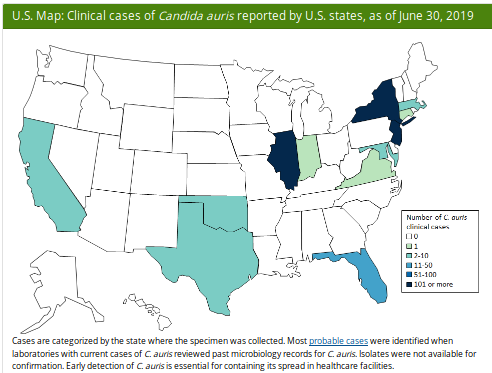#14,261
While they may not be in the same league as bacterial and viral diseases, fungal infections can present a serious, hard to diagnose, and challenging to treat infection.
Perhaps the best known North American fungal infection is Valley fever', aka Coccidioidomycosisis – caused by the inhalation of spores from one of two soil borne fungi - Coccidioides immitis or C. posadasii - both commonly found in the American Southwest.
These spores can remain dormant in the desert soil for years, only to become airborne when the earth is disturbed by farming, earthquakes, construction, or windstorms.
Most people who live in regions where these fungi are endemic are eventually exposed and either develop brief asymptomatic infections or mild flu-like symptoms (see MMWR: Coccidioidomycosis Rising). But some can go on to develop severe, even fatal, illness.Another mycotic disease with a wide range in the United States is called Histoplasmosis, which can be found in the Ohio River Valley and along the lower Mississippi river. The causative agent is Histoplasma capsulatum, a fungus which is found in bird and bat droppings. Its spores can become airborne when these droppings dry out and are picked up by the wind.
Over the years we've looked at a number of other fungal disease threats, including:
EID Journal: Whole-Genome Analysis of Cryptococcus gattii, Southeastern United States
MMWR: Multistate Outbreak Of Fungal Meningitis
mBio: The Remarkable Evolution Of Cryptococcus Gatti
UK: Rising Pneumocystis PneumoniaBecause fungal infections can present with non-specific, flu-like symptoms, they can be very difficult to diagnose early. Every year the CDC sponsors a Fungal Awareness Week in order to remind healthcare providers, and patients, to:
Think Fungus: Fungal Disease Awareness Week
Fungal Disease Awareness Week is September 23–27, 2019. CDC and partners have organized this week to highlight the importance of recognizing serious fungal diseases early enough in the course of a patient’s illness to provide life-saving treatment.
Some fungal diseases go undiagnosed and cause serious infections in people in the United States and around the world, leading to illness and death. Increased awareness about fungal diseases is one of the most important ways we can improve early recognition and reduce delays in diagnosis and treatment. A key clue to when a sick person may have a fungal infection is that he or she is being treated with medications for other types of infection but does not get better.
We encourage healthcare providers and their patients to “Think Fungus” when symptoms of infection do not get better with treatment.(Continue . . . )
For the past three years we've been following the emergence and spread of a recently identified fungal pathogen - Candida auris - which appeared nearly simultaneously around the globe (see Candida Auris: CDC July Update).
The number of identified infections remains small, but the rise of C. auris is of particular concern because:
The most recent update from the CDC (current through June 30th) finds 755 confirmed and probable cases, along with an additional 1474 patients found to be colonized with C. auris by targeted screening in ten states with clinical cases.
- C. auris infections have a high fatality rate
- The strain appears to be resistant to multiple classes of anti-fungals
- This strain is unusually persistent on fomites in healthcare environments.
- And it can be difficult for labs to differentiate it from other Candida strains
Tracking Candida auris
August 16, 2019: Case Count Updated as of June 30, 2019
Candida auris is an emerging fungus that presents a serious global health threat. C. auris causes severe illness in hospitalized patients in several countries, including the United States. Patients can remain colonized with C. auris for a long time and C. auris can persist on surfaces in healthcare environments. This can result in spread of C. auris between patients in healthcare facilities.
Most C. auris cases in the United States have been detected in the New York City area, New Jersey, and the Chicago area. Strains of C. auris in the United States have been linked to other parts of the world. U.S. C. auris cases are a result of inadvertent introduction into the United States from a patient who recently received healthcare in a country where C. auris has been reported or a result of local spread after such an introduction.
(Continue . . . )
A month ago, in mBio: On the Emergence of Candida auris: Climate Change, Azoles, Swamps, and Birds, we looked at a hypothesis by authors
While still a theory, if proven correct, climate change could exacerbate the appearance of additional fungal threats down the road.
And lastly, a couple of months ago the CDC held an hour-long COCA (Clinician's Outreach & Communications Activity) call on the emerging threat of C. auris.
Multidrug-resistant Candida auris: Update on Current U.S. Epidemiology, Clinical Profile, Management, and Control StrategiesThe full video of this webinar presentation is posted at the above link, along with slides.




